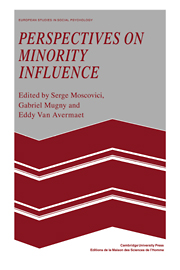Book contents
- Frontmatter
- Contents
- Contributors
- Preface
- Part I The process of minority influence
- Introduction
- 1 Innovation and minority influence
- 2 Social support and minority influence: the innovation effect reconsidered
- 3 Compromising public influence for private change
- 4 Conflict and conversion
- 5 Rigidity and minority influence: the influence of the social in social influence
- Part II Minority influence in groups
- References
- Subject index
- Author index
2 - Social support and minority influence: the innovation effect reconsidered
Published online by Cambridge University Press: 05 February 2012
- Frontmatter
- Contents
- Contributors
- Preface
- Part I The process of minority influence
- Introduction
- 1 Innovation and minority influence
- 2 Social support and minority influence: the innovation effect reconsidered
- 3 Compromising public influence for private change
- 4 Conflict and conversion
- 5 Rigidity and minority influence: the influence of the social in social influence
- Part II Minority influence in groups
- References
- Subject index
- Author index
Summary
Introduction
Recent social influence theorising (Moscovici, 1976, 1980) departs from the assumption that the two major influence modalities – innovation and conformity – involve different processes and produce divergent behavioural effects. It has been assumed that majorities would elicit a social comparison process, direct a person's attention to the interpersonal relations and produce compliance effects. Minorities on the other hand would trigger a judgment validation process, direct a person's attention to the object of judgment and produce conversion effects. Empirical support for this line of thought can be found in numerous studies which show that majorities exert more influence on public responses than minorities, whereas the reverse holds with respect to private or latent responses (Lage 1973; Mugny, 1974–5, 1976; Moscovici & Lage, 1976; Nemeth, 1976; Moscovici & Personnaz, 1980).
Paradoxical as it may seem, part of the very same evidence may serve as a point of departure for an alternative conception of the relation between innovation and conformity, namely one that stresses their similarities rather than their differences. The present chapter intends to re-analyse existing data from this perspective and it will also introduce some new empirical evidence. It invites the reader seriously to consider an emerging parallel between both influence processes, at least with respect to their public effects.
A first section of this chapter will briefly recapitulate our earlier efforts to re-analyse the current operationalisation of the comparison between both influence processes from the perspective of the literature on the role of social support within social influence contexts.
- Type
- Chapter
- Information
- Perspectives on Minority Influence , pp. 53 - 74Publisher: Cambridge University PressPrint publication year: 1985
- 7
- Cited by



